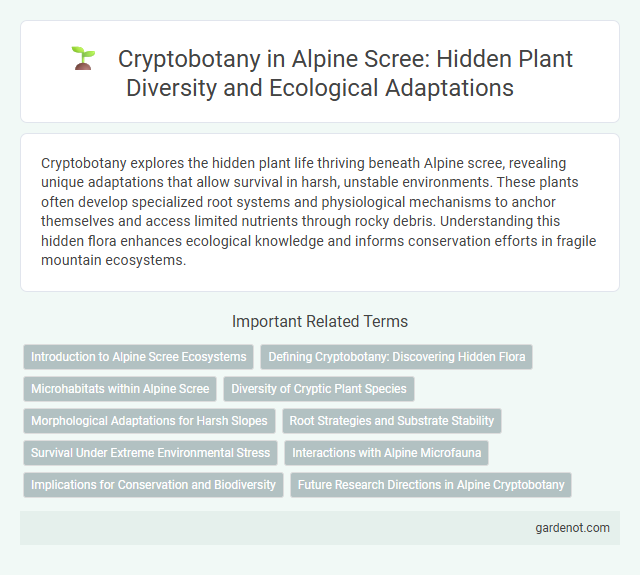Cryptobotany explores the hidden plant life thriving beneath Alpine scree, revealing unique adaptations that allow survival in harsh, unstable environments. These plants often develop specialized root systems and physiological mechanisms to anchor themselves and access limited nutrients through rocky debris. Understanding this hidden flora enhances ecological knowledge and informs conservation efforts in fragile mountain ecosystems.
Introduction to Alpine Scree Ecosystems
Alpine scree ecosystems, characterized by loose rock debris on mountain slopes, present unique challenges for plant colonization due to harsh conditions like temperature fluctuations and limited soil development. Cryptobotany studies reveal that specialized cryptogams, including mosses, liverworts, and lichens, dominate these environments by exhibiting adaptations such as desiccation tolerance and efficient nutrient absorption. These pioneer species play critical roles in soil stabilization and nutrient cycling, facilitating the gradual establishment of vascular plants in alpine scree habitats.
Defining Cryptobotany: Discovering Hidden Flora
Cryptobotany involves the study and discovery of hidden or elusive plant species often found in challenging environments like alpine scree. This subfield emphasizes identifying cryptic flora that remain undetected due to their small size, camouflage, or remote habitats in rocky scree slopes. Research in cryptobotany contributes to biodiversity knowledge, revealing rare alpine plants adapted to extreme conditions.
Microhabitats within Alpine Scree
Microhabitats within alpine scree provide unique ecological niches that support diverse cryptobotanical species adapted to extreme conditions, such as cold stress and nutrient-poor substrates. These microhabitats feature variations in moisture, temperature, and soil composition, fostering cryptogamic plants like mosses, liverworts, and lichens critical for alpine ecosystem stability. Studying these specialized environments enhances understanding of cryptobotany and aids conservation of biodiversity in fragile high-altitude scree ecosystems.
Diversity of Cryptic Plant Species
Alpine scree hosts a remarkable diversity of cryptic plant species, characterized by their specialized adaptations to harsh, unstable environments with minimal soil. These plants often exhibit unique phenotypic traits that enable camouflage and protection against extreme temperature fluctuations and intense UV radiation. Studies reveal that cryptobotanical diversity in scree ecosystems contributes significantly to overall alpine biodiversity and ecosystem resilience.
Morphological Adaptations for Harsh Slopes
Cryptobotanical studies reveal that alpine scree plants exhibit specialized morphological adaptations such as compact growth forms, reduced leaf size, and robust root systems to anchor in unstable, rocky substrates. These adaptations minimize water loss and protect against mechanical damage from shifting scree, enhancing survival in cold, nutrient-poor environments. Morphological traits like cushion-shaped rosettes and dense trichomes optimize microclimates essential for photosynthesis under extreme alpine conditions.
Root Strategies and Substrate Stability
Cryptobotany research on alpine scree emphasizes root strategies that enhance substrate stability by anchoring plants in loose, rocky terrain. Specialized root systems penetrate deep crevices, facilitating nutrient absorption and reducing soil erosion on unstable scree slopes. These adaptive root mechanisms are crucial for sustaining plant communities in high-altitude alpine environments.
Survival Under Extreme Environmental Stress
Cryptobotany explores the adaptive mechanisms of alpine scree plants, revealing how specialized root systems and antifreeze proteins enable survival under extreme environmental stress. These cryptic botanical species exhibit drought resistance and temperature tolerance by modulating cellular osmolytes and producing protective secondary metabolites. Understanding these survival strategies enhances conservation efforts and informs climate change resilience models for alpine ecosystems.
Interactions with Alpine Microfauna
Cryptobotany studies reveal that Alpine scree environments provide critical habitats fostering interactions between cryptogams and Alpine microfauna. Mosses and lichens found on scree slopes offer shelter and nutritional resources for microarthropods, influencing nutrient cycling and soil formation. These symbiotic relationships are essential for ecosystem resilience and maintaining biodiversity in harsh alpine conditions.
Implications for Conservation and Biodiversity
Cryptobotany in alpine scree environments reveals hidden plant species adapted to extreme conditions, playing a crucial role in maintaining biodiversity and ecosystem stability. Understanding these cryptic plants supports targeted conservation strategies that protect fragile alpine habitats from climate change and human disturbance. Preserving cryptobotanical diversity ensures the resilience of alpine scree ecosystems and the survival of specialized flora.
Future Research Directions in Alpine Cryptobotany
Future research directions in alpine cryptobotany emphasize the integration of advanced remote sensing technologies and high-throughput DNA sequencing to map and identify cryptogamic species on alpine scree slopes. Investigating microhabitat specificity and physiological adaptations will enhance understanding of their resilience to climate change and extreme environmental gradients. Expanding genomic databases and applying machine learning models can facilitate predictive analytics for species distribution under future alpine ecosystem scenarios.
Cryptobotany Infographic

 gardenot.com
gardenot.com